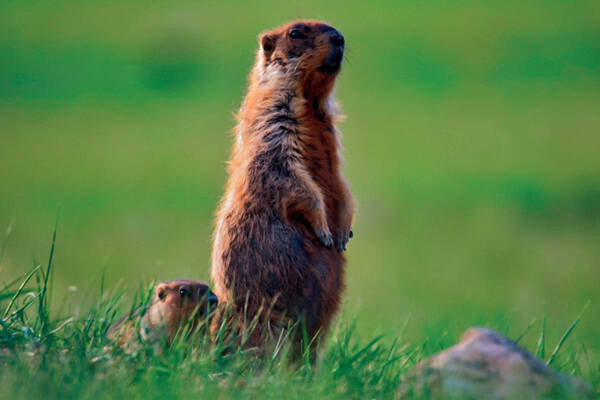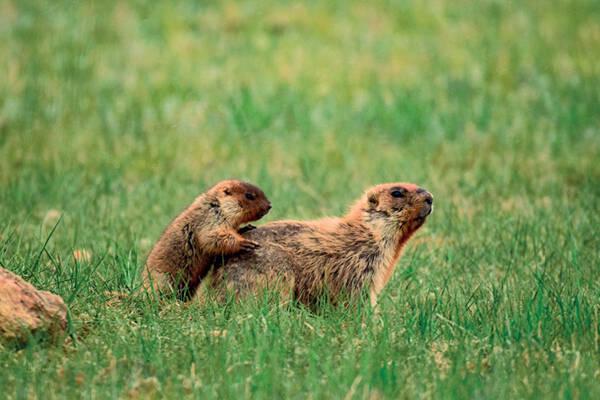Marmota sibirica
IUCN
LCBasic Information
Scientific classification
- name:Marmota sibirica
- Scientific Name:Marmota sibirica,,Marmota bobak,Bobak Marmot,Siberian marmot, steppe marmot, Tarbagan (Mongolian)
- Outline:Rodents
- Family:Rodentia Sciuridae Marmota
Vital signs
- length:360-495mm
- Weight:2.2-5.5kg
- lifetime:
Feature
It has a large and sturdy body, short round ears and a short tail, and its fur is brown or yellowish brown.
Distribution and Habitat
In China, it is distributed in Inner Mongolia and Heilongjiang. Abroad, it is distributed in Mongolia and Russia.
It mainly lives in dry steppe areas.
Appearance
The body is stout. The tail is less than 1/3 of the body length; the feet are relatively wide, the claws are thick and short, the third toe of the front foot is the longest, and the big toe is degenerate. The body has two color types: brown and yellowish brown. The upper part of the head from the nose pad to the base of the ear (excluding the ears) is black or dark brown, and there is a long white strip on the chin. The back hair is dirty white or yellowish brown, the hair base is brown or brown-black, and the hair tips are brown or yellowish brown. The cheeks under the eyes, the sides of the neck, the limbs and the front and back feet are almost all light ochre yellow to light yellow, and the difference between the light white ring and the brown hair tips is smaller than the back. The groin is sometimes more or less black. The tail end is rusty brown on both the dorsal and ventral sides.
Details
The Mongolian marmot is a rodent, Marmota genus animal. There are two color types, one is brown and the other is yellow-brown; it lives in mountainous areas above 1500m above sea level or hilly grassland areas above 600m, avoiding deserts, but occasionally seen in the marginal areas where grasslands and deserts intersect. The cave groups in its habitat are arranged in strips or sheets. It mostly chooses mountainsides and slopes, where there are fewer ridges, as its habitat. Its selectivity for shady and sunny slopes is not very obvious, but it is slightly more on sunny slopes.

Mongolian marmots are hibernating animals. In a year, the active period and hibernation period account for almost half each. They come out of hibernation from the Spring Equinox to Qingming Festival, that is, from late March to early April. The date of coming out of hibernation is related to the time when the local climate warms up. The date of coming out of hibernation for those living on the shady slopes differs by about 10 days from that for those living on the sunny slopes. The order of coming out of hibernation is first for adults and then for young otters. Marmots that have just come out of hibernation are weaker in physique and move slowly. They come out late and return early every day, and their time outside is shorter. About 10 days after coming out of hibernation, the metabolic function begins to return to normal. The hibernation period is from the autumnal equinox to before the cold dew, that is, from late September to mid-October. Before hibernation, the marmot first cleans the dirt in the cave, and then carries grass into the cave. After entering the cave, it blocks the cave entrance with mud and feces from the inside, and then lies in the nest head to tail, entering the hibernation period.
Mongolian marmots are active during the day, and their daily activities vary with local climate changes. Generally, the daily activity is the largest in June and July, and they come out of the cave before and after sunrise and stop after sunset. They are most active in spring from 9:00 to 17:00, and rarely active at noon. They stop moving on rainy days, but become very active when the rain stops and the sky clears. In autumn, their activity gradually decreases, and they come out of their caves later, usually between 10:00 and 14:00. If a cold wave hits or human interference occurs, they will stay in their caves. After coming out of their caves, marmots first stand on the marmot hills to look out. When there is no enemy, 2-3 of them gather to move and forage. They are very alert when they are active. If they find an enemy, they will make a sound to inform the whole group, and continue to stand in front of the cave entrance to look out. If the enemy approaches, they will quickly rush into the cave, and will not leave the cave until the enemy is far away. When the young otter starts to move out of the cave, the mother otter does not leave the area around the cave entrance to keep a vigilant eye.

Mongolian marmots molt once a year. Molting begins in late May and early June. The color of the marmot's fur after molting (autumn fur) is obviously different from that of the fur after hibernation (spring fur): the autumn fur is sandy yellow, fine and flat, plush, and shiny, while the spring fur is light yellow, thick and long, and not shiny.
The caves of Mongolian marmots are distributed in cave groups, and they live in families. Each family has 47 marmots, with as many as 10-12 and as few as one pair. According to the use of caves by each family and the appearance of the caves, they can be divided into three types. The main cave (hibernation system) is the main cave where marmots live, and they hibernate in winter.
Mongolian marmots mainly feed on plant food, eating grass shoots and tender roots in spring, and stems and leaves in summer and autumn. During the winter, there is a slight phenomenon of food storage, and the stored food includes grass, plant roots and seeds. Marmots mainly rely on moisture in plants and dew on grass or water droplets after rain for their metabolic needs.
After the Mongolian marmot comes out of hibernation, it goes through a period of recovery, which takes about 10 days before mating begins. Mating begins in April, the gestation period is about 40 days, the pregnancy rate is 56.4%, and each litter has 2-9 pups, with an average of 5.9 pups. From mid-June, young otters emerge from their dens in large numbers. After two hibernations, young otters reach sexual maturity when they are over two years old.
In Mongolia, this species is scattered due to hunting, and its number is estimated to have dropped by 70%. The Mongolian marmot is an endangered species in Russia and its population is declining. Its overall population is on a downward trend.








